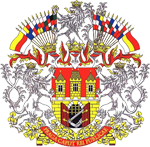Prague - The Golden City
Prague (Czech: Praha) is the larger city and principal of the Czech republic. Established on Vltava the river in central B?hmen, to approximately 1.2 million people a head is him. there ( the 300.000 additional ones can be derived from the statistics of employment however to have worked to have recorded as
inhabitants.)
Nicknames for Prague have included "city of a hundred spires" and "the golden city". Since 1992, the historical medium of Prague was included/understood in UNESCO lists of World Heritage Sites. |

Prague City Logo
|
History | Culture | Economy | Transportation | Prague Hotels
|
History |
The Czech republic is a Central European country (comamment of the historical areas of Bohemia, Moravia and Silesia) which was inhabited in since the first days of the human payment in Europe.
The area on which Prague was founded was settled in ancient times since the Paleolithic Age. Around 200 BCE the Celts had a settlement in the south, called Z?vist, but later they were expelled by Germans. The Slavs conquered the site from the 4th century CE onwards, though for a period were subdued by the Eurasian Avars.
According to a legend, Prague was founded by the Princess Libu?e and her husband, Pr(emysl, founder of the dynasty with the same name. Whether this legend is true or not, Prague's first nucleus was founded in the latter part of the 9th century as a castle on a hill commanding the right bank of the Vltava: this is known as Vy?ehrad
("high castle") to differentiate from another castle which was later erected on the opposite bank, the future Prague Castle. Soon the city became the seat of the kings of Bohemia. It was an important seat for trading where merchants coming from all Europe settled, including many Jews, as recalled in 965 by the Jewish merchant and
traveler Ibrahim ibn Ya'qub. The city became a bishopric in 973.
King Vladislav II had a first bridge on the Vltava built in 1170, the Judith Bridge, which crumbled down in 1342. The Charles Bridge was later built on its foundings.
In 1257, under King Otakar II, Mal? Strana ("Small Side") was founded in Prague in the future Hradc(any area: it was the district of the German people. These had the right to administrate the law autonomously, pursuant to Magdeburg Rights. The new district was on the opposite bank of the Star? Mesto ("Old Town"), which had a borough
status and was defended by a line of walls and fortifications.
|
go up  |
Culture |
The National Theatre in Prague is known as the Alma Mater of Czech Opera, and as the national monument of Czech history and art.
The National Theatre belongs to the most important Czech cultural institutions with a rich artistic tradition which was created and maintained by the most distinguished personalities in Czech society. This tradition helped to preserve and develop the most important features of the nation ? the Czech language and a sense for a Czech
musical and dramatic way of thinking.
The Rudolfinum is one of the most important neo-renaissance buildings in Prague. It is named after the Austrian crown prince and situated at the Palach square on the bank of the river Vltava. Currently it is the home-stage of the Czech Philharmonic Orchestra.
National museum is a Czech institution intended to systematically establish, prepare and publicly exhibit natural scientific and historical collections. It was founded 1818 in Prague. At present the National Museum shelters almost 14 million of items from the area of natural history, history, arts, music and
librarianship, located in tens of buildings.
The Clementinum (Klementinum in Czech) is the name of the building housing the national library of the Czech Republic situated in Prague.
The National Gallery in Prague is the Czech National Gallery in Prague. It is housed in different locations within the city, the largest being the Veletrzni Palac.
|
go up  |
Economy |
The GDP per capita of Prague is more than double that of the Czech Republic as a whole, with a per-capita GDP (PPP) of EUR 32,357 in 2002, which is at 153% of the European Union average. The city is becoming a site of European headquarters of many international companies.
Since the late 1990s, Prague has become a popular filming location for international productions and Hollywood motion pictures. Unlike many other European cities, Prague did not suffer great destruction during World War II, and the city is often used as a "stand in" for other pre-WW2 European cities, such as Amsterdam or London. A
combination of architecture, low costs, tax breaks, and the existing motion picture infrastructure have proved attractive to international film production companies.
|
go up  |
Transportation |
Integrated transport system
Public transport infrastructure consists of an integrated transport system of three metro lines, trams (including the "nostalgic tram" no. 91), buses, a funicular to Petr(?n Hill and a chairlift at Prague Zoo. All services have a common ticketing system
- Rail Prague has two international railway stations, Hlavn? n?dra?? (sometimes referred to as Wilsonovo n?dra??) and Praha Hole?ovice. Intercity services also stop at the main stations Praha Sm?chov and Masarykovo n?dra??. In addition to these, there are a number of smaller suburban stations.
- Air Prague is served by Ruzyne( International Airport, which is the hub of the flag carrier, Czech Airlines. There are several cheap flights per day from the UK and from other countries.
- Taxis
|
go up  |
|

